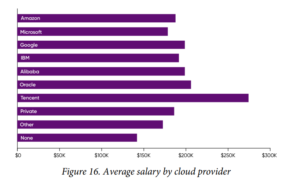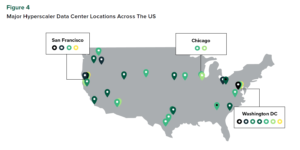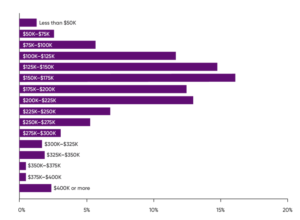
As Cloud Coverage Expands, Salaries Also Rise

(ArtemisDiana/Shutterstock)
The march to the cloud continued in 2021, as hyperscalers opened more data centers and customers ran more workloads in the cloud. As the cloud becomes the defacto standard platform for transactional and analytical workloads–as well as a new class of edge apps–demand for workers skilled in working in the cloud also rose, and that helped drive the average salary of cloud workers to nearly $200,000, a survey found.
Dirt continued to be broken around the country for new data centers. According to Forrester’s State of the Cloud in the US report, Microsoft Azure opened an Arizona region in 2021, while Google Cloud plans to open new region in Columbus, Ohio, and Dallas, Texas in 2022. AWS, meanwhile, opened 15 new local zones in 2021, with 30 new zones planned across the world in 2022.
These data centers represent hundreds of millions of dollars of investment, and they wouldn’t be built without lots of demand. Forrester cited an independent study of “infrastructure decision-makers” that found 45% of application portfolios have already been migrated to the cloud, with another 13% planned by 2023. The footprint of on-prem applications continues to shrink.
Nearly all American companies (94%) use the cloud in some fashion, whether public, private, or hybrid cloud, according to a 2021 Forrester Analytic Business Technographics Infrastructure Survey. More than four out of five (81%) use a hybrid cloud, while 75% use multiple public clouds.
These figures have gone up considerably in recent years, as COVID-19 was a major driver in cloud adoption, Forrester days. “For the US, the biggest impact was the global pandemic, which sparked a massive acceleration in cloud strategies,” the authors of the report write. “Industry-specific clouds and edge conversations dominated the market dialog at major US events. And many enterprises are keeping tabs on data center locales and the potential implications that might have for a pan-US data center strategy.”
Another hot cloud topic is edge. “Cloud native at the edge is all the rage,” Forrester declared. Customers are interested in containers and container orchestration on the edge, such as through lightweight Kubernetes (dubbed K3s, MicroK8s, or K0s). they’re also interested in “microvirtual” machines, service meshes, and V8 isolates (Google’s open source JavaScript engine), among other functions.
These technologies not only power hybrid apps that run on a combination of public and private clouds on the edge, Forrester says, but they also open the door to workload affinity. “Run your workload where you want, even if that decision changes in the life of that app,” the analyst group says.
Cloud Salaries Rising
Meanwhile, a new salary survey of cloud workers by O’Reilly Media illustrates the state of the Great Cloud Migration from the point of view of the worker.
According to O’Reilly’s 2022 Cloud Salary Survey, which involved about 1,400 respondents, the average cloud professional is paid a salary of $182,000 per year, which is a 4.3% increase from last year. The survey also found that 20% of surveyed workers had changed jobs in the last year, and that 25% planned to leave in the future due to compensation.
“We believe that job changes are part of what’s driving high salaries,” writes the report’s author, Mike Loukides, who is O’Reilly’s vice president of content strategy. “After all, we’ve heard about talent shortages in almost every field, with many employers offering very high salaries to attract the staff they need. By staying with their current employer, an employee may get an annual salary increase of 4%. But if they change jobs, the might get a significantly higher offer—20% or more—plus a signing bonus.”
While workers currently hold the advantage in salary negotiations, that might not last long, according to Loukides, who cites stock market correction that began in March 2022 and “significant layoffs from some large technology-sector companies” as indications that the power may be shifting back to employers.
O’Reilly also looked at certifications in the cloud. Most of the certifications cited by survey respondents were tied to specific clouds, such as AWS Certified Cloud Practitioner and Solutions Architect.
Those holding a Google Cloud Certified Professional Cloud Architect certificate earned the highest average salary, at $231,000. “Those who obtained an AWS Certified Solutions Architect- Professional, AWS Certified Solutions Architect – Associate, or Microsoft Certified: Azure Solutions Architect Expert certification also earn very high salaries ($212,000, $201,000, and $202,000),” Loukides wrote.

Google Cloud maintained a slide edge over other public clouds in terms of user salaries (Source: O’Reilly 2022 Cloud Salary Survey)
The only cloud-related certificates that weren’t tied to a specific cloud were CKA (Certified Kubernetes Administrator) and CKAD (Certified Kubernetes Application Developer), but the numbers were relatively low.
Python was the dominant language cited by O’Reilly’s cloud survey participants, as one would expect, followed by SQL, JavaScript, and Java. However, the prevalence of use of a language is not correlated with salaries.
“Although the top four languages are in high demand, they don’t command particularly high salaries: $187,000 for Python, $179,000 for SQL, $181,000 for JavaScript, and $188,000 for Java,” Loukides wrote. “These are all ‘table stakes’ languages: they’re necessary and they’re what most programmers use on the job, but the programmers who use them don’t stand out.”
Use of more obscure languages can lead to a higher salary. The survey shows Scala, Rust, or Go users had salaries of $211,000, $202,000, and $210,000, respectively.
“While the demand for these languages isn’t as high, there’s a lot less available expertise,” Loukides writes. “Furthermore, fluency in any of these languages shows that a programmer has gone considerably beyond basic competence. They’ve done the work necessary to pick up additional skills.”
Related Item:
Salaries Climbed in 2021, But ML and AI Paid Less, Dice Reports
Battle for Data Pros Heats Up as Burnout Builds
Data and AI Salaries Continue Upward March, O’Reilly Says
































